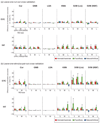Comparison of multivariate classifiers and response normalizations for pattern-information fMRI
- PMID: 20580933
- PMCID: PMC2914143
- DOI: 10.1016/j.neuroimage.2010.05.051
Comparison of multivariate classifiers and response normalizations for pattern-information fMRI
Abstract
A popular method for investigating whether stimulus information is present in fMRI response patterns is to attempt to "decode" the stimuli from the response patterns with a multivariate classifier. The sensitivity for detecting the information depends on the particular classifier used. However, little is known about the relative performance of different classifiers on fMRI data. Here we compared six multivariate classifiers and investigated how the response-amplitude estimate used (beta- or t-value) and different pattern normalizations affect classification performance. The compared classifiers were a pattern-correlation classifier, a k-nearest-neighbors classifier, Fisher's linear discriminant, Gaussian naïve Bayes, and linear and nonlinear (radial-basis-function kernel) support vector machines. We compared these classifiers' accuracy at decoding the category of visual objects from response patterns in human early visual and inferior temporal cortex acquired in an event-related design with BOLD fMRI at 3T using SENSE and isotropic voxels of about 2-mm width. Overall, Fisher's linear discriminant (with an optimal-shrinkage covariance estimator) and the linear support vector machine performed best. The pattern-correlation classifier often performed similarly as those two classifiers. The nonlinear classifiers never performed better and sometimes significantly worse than the linear classifiers, suggesting overfitting. Defining response patterns by t-values (or in error-standard-deviation units) rather than by beta estimates (in % signal change) to define the patterns appeared advantageous. Cross-validation by a leave-one-stimulus-pair-out method gave higher accuracies than a leave-one-run-out method, suggesting that generalization to independent runs (which more safely ensures independence of the test set) is more challenging than generalization to novel stimuli within the same category. Independent selection of fewer more visually responsive voxels tended to yield better decoding performance for all classifiers. Normalizing mean and standard deviation of the response patterns either across stimuli or across voxels had no significant effect on decoding performance. Overall our results suggest that linear decoders based on t-value patterns may perform best in the present scenario of visual object representations measured for about 60min per subject with 3T fMRI.
Published by Elsevier Inc.
Figures







Similar articles
-
Sparse estimation automatically selects voxels relevant for the decoding of fMRI activity patterns.Neuroimage. 2008 Oct 1;42(4):1414-29. doi: 10.1016/j.neuroimage.2008.05.050. Epub 2008 Jun 6. Neuroimage. 2008. PMID: 18598768 Free PMC article.
-
Pattern classification of fMRI data: applications for analysis of spatially distributed cortical networks.Neuroimage. 2014 Aug 1;96:117-32. doi: 10.1016/j.neuroimage.2014.03.074. Epub 2014 Apr 4. Neuroimage. 2014. PMID: 24705202
-
Multiclass fMRI data decoding and visualization using supervised self-organizing maps.Neuroimage. 2014 Aug 1;96:54-66. doi: 10.1016/j.neuroimage.2014.02.006. Epub 2014 Feb 12. Neuroimage. 2014. PMID: 24531045
-
Pattern-information analysis: from stimulus decoding to computational-model testing.Neuroimage. 2011 May 15;56(2):411-21. doi: 10.1016/j.neuroimage.2011.01.061. Epub 2011 Jan 31. Neuroimage. 2011. PMID: 21281719 Review.
-
Machine learning classifiers and fMRI: a tutorial overview.Neuroimage. 2009 Mar;45(1 Suppl):S199-209. doi: 10.1016/j.neuroimage.2008.11.007. Epub 2008 Nov 21. Neuroimage. 2009. PMID: 19070668 Free PMC article. Review.
Cited by
-
Multivariate Connectome-Based Symptom Mapping in Post-Stroke Patients: Networks Supporting Language and Speech.J Neurosci. 2016 Jun 22;36(25):6668-79. doi: 10.1523/JNEUROSCI.4396-15.2016. J Neurosci. 2016. PMID: 27335399 Free PMC article.
-
Brain response pattern identification of fMRI data using a particle swarm optimization-based approach.Brain Inform. 2016 Sep;3(3):181-192. doi: 10.1007/s40708-016-0049-z. Epub 2016 Apr 7. Brain Inform. 2016. PMID: 27747594 Free PMC article.
-
Neural Population Decoding Reveals the Intrinsic Positivity of the Self.Cereb Cortex. 2017 Nov 1;27(11):5222-5229. doi: 10.1093/cercor/bhw302. Cereb Cortex. 2017. PMID: 27664966 Free PMC article.
-
From words to phrases: neural basis of social event semantic composition.Brain Struct Funct. 2022 Jun;227(5):1683-1695. doi: 10.1007/s00429-022-02465-2. Epub 2022 Feb 20. Brain Struct Funct. 2022. PMID: 35184222 Free PMC article.
-
Interactions of a medicinal climber Tinospora cordifolia with supportive interspecific plants trigger the modulation in its secondary metabolic profiles.Sci Rep. 2019 Oct 4;9(1):14327. doi: 10.1038/s41598-019-50801-0. Sci Rep. 2019. PMID: 31586109 Free PMC article.
References
-
- Bishop CM. Pattern Recognition and Machine Learning. New York: Springer; 2007.
-
- Björnsdotter Åberg M, Löken L, Wessberg J. An Evolutionary Approach to Multivariate Feature Selection for FMRI Pattern Analysis. BIOSIGNALS. 2008;(2):302–307. 2008.
-
- Chang C-C, Lin C-J. LIBSVM: a library for support vector machines, Software. 2001. available at http://www.csie.ntu.edu.tw~cjlin/libsvm.
-
- Cox DD, Savoy RL. Functional magnetic resonance imaging (fMRI) "brain reading": detecting and classifying distributed patterns of fMRI activity in human visual cortex. NeuroImage. 2003;19:261–270. - PubMed
Publication types
MeSH terms
Grants and funding
LinkOut - more resources
Full Text Sources
Medical

